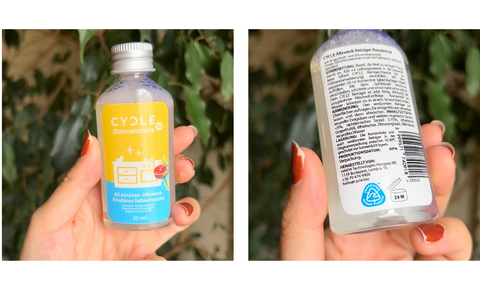Prevented Ocean Plastic or POP is a high-quality, fully certified plastic that is recycled from discarded plastic waste from coastal areas at risk of ocean plastic pollution. This means that plastic bottles are collected from beaches, seashores and major waterways to help reduce pollution in our waters.

The spread of POP can really make a difference, because by the time a plastic bottle ends up in the water, it’s too late. The combination of sunlight and seawater causes the plastic to break down, making it largely impossible to recycle. In such cases, the only option is to clean the water, so the focus shifts from recycling to this. POP tackles the problem at its root, preventing plastic from entering the sea.

How does the Prevent Ocean Plastic program work in practice? We explain in 4 steps how plastic bottles thrown on the beach are transformed into sustainable packaging that ends up in our baskets - from collection to recycling.
Step 1 : Collect plastic bottles
Plastic bottles are collected by plastic collectors from areas at risk of ocean pollution. The areas at risk include Southeast Asia, South America and the Galapagos Islands, Central America and the Caribbean, and the Mediterranean Sea.

The collected plastic bottles are then transported to local collection centers where they are exchanged for money. This encourages and supports the efforts of the bottle collectors, providing them with a steady income while contributing greatly to the noble cause of recycling.

Step 2: Selection and delivery
Upon arrival at the collection centers, the plastic bottles undergo meticulous sorting. After sorting, the plastic bottles are pressed into bales for convenient transportation. These bales are then transported to plastic recycling factories.

Step 3: Washing, disinfecting and processing
In the recycling plant, the plastic bottles undergo thorough washing and disinfection to remove contaminants. After washing, the plastic bottles are processed into raw material flakes or pellets. This is achieved by cutting, shredding and other size reduction methods. The resulting flakes or pellets serve as building blocks for creating new plastic products.

This recycling process meets European and North American quality standards, ensuring that the recycled plastic meets safety and performance standards.
Step 4: New life as packaging
The life of recycled plastic is certified traceable from collection at the shoreline to becoming sustainable recycled packaging on supermarket shelves.

Understanding the positive environmental impacts of POP makes it easy to understand why CYCLE, a sustainable cleaning company committed to protecting our environment, joined this movement. It’s no wonder we chose POP packaging for our limited-edition summer 10X concentrate.

By choosing sustainable, recycled packaging, we want to express our active commitment to recycling, thereby taking steps to reduce the demand for virgin plastics. We hope that this will inspire both the consumer society and the industry to make the best possible decisions when purchasing, moving together towards a more sustainable and environmentally friendly future.




